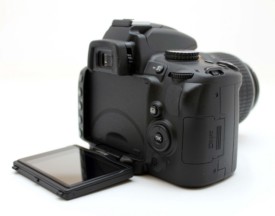Nikon D5000 DSLR Review
Features and Technology

As we suggested, the D5000's 2.7-inch Vari-angle LCD monitor helps to set the D5000 apart from some of its competition. Unlike some articulating screens we've seen in the past that hinge from the side, the D5000's LCD hinges at the bottom. All in all, the placement of the hinge is mostly personal preference, though we do want to point out if you're using this camera on a tripod, the tripod may restrict some of the angles of rotation. When you're transporting the camera, you can tuck the LCD against the camera back to better protect it.
The screen itself has 230,000 Dots, which isn't bad, but you definitely notice a difference in the screen and image quality if you compare the D5000's LCD to a camera that has a higher resolution display. Generally speaking, there's a tradeoff: In this class of cameras, you can have an articulating display or a high-resolution display. Take your pick, but right now, you're not likely to find both in a consumer-grade camera. If you rotate the camera, the D5000's LCD changes to portrait.
The D5000 offers four Live View autofocus shooting modes: Subject Tracking autofocus (AF), Face Priority AF, Wide Area AF, and Normal Area AF. Subject Tracking AF locks the focus on a moving subject. Even if that subject should leave the frame and return, the camera will maintain focus on the subject. This AF mode is particularly useful when capturing fast moving children as well as pets. As you will guess from its name, Face Priority AF uses face recognition technology to detect up to five faces in a scene and focuses on the closest subject. Wide Area AF gives you a large AF area and is ideal for hand-held shooting. Finally, Normal Area AF is useful when you're shooting with a tripod and desire pinpoint accuracy.
Like other DSLRs with HD video recording capabilities, the D5000 lets you use an assortment of AF-S NIKKOR interchangeable lenses with the video capture feature. This gives you a lot more versatility than you'd get with a traditional, fixed-lens camcorder. In addition, if you're capturing video with a NIKKOR VR lens, you'll also get the added benefits of Nikon VR image stabilization which helps you get a sharper image that's more stable. VR image stabilization also works to extend the D5000’s performance in low-light situations. The D5000 records movie clips in Motion JPEG AVI files. A small microphone on the front of the camera records sound.
Users who are upgrading from a point and shoot digital camera will likely appreciate the D5000's 19 automatic Scene Modes. Some of these modes include Sports, Portrait, Candlelight, Silhouette, and Autumn Colors.
The D5000 also offers a handful of in-camera editing features to avoid post-processing time after pictures are uploaded to your computer. The D5000's newest editing features include a Soft Filter effect, Perspective Control, and Color Outline. Other editing features include a straighten option, red-eye correction, image overly, and more. Anytime you edit an image on the camera, the D5000 will save the new image as a separate JPEG file to preserve the original image.
Behind the scenes, the D5000 uses Nikon’s EXPEED image processing system and a 12.3-megapixel CMOS sensor. The D5000’s normal ISO range extends from ISO 200 to 3200. For hard to get shots, the D5000 also offers two ISO expansion settings—Lo 1 for ISO 100 or Hi 1 for ISO 6400. Nikon’s 3D Color Matrix Metering II works with the camera's EXPEED image processing system to evaluate the exposure elements in a scene and provide the best exposure.
To help the D5000 deliver spot-free images, Nikon has included its Integrated Dust Reduction System which incorporates both an electronic sensor cleaning as well as the Airflow Control System which helps to direct dust away from the sensor.








